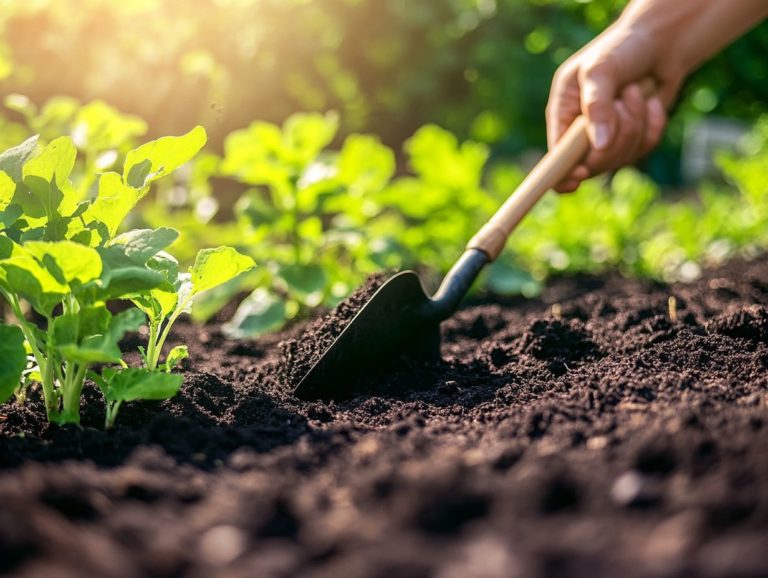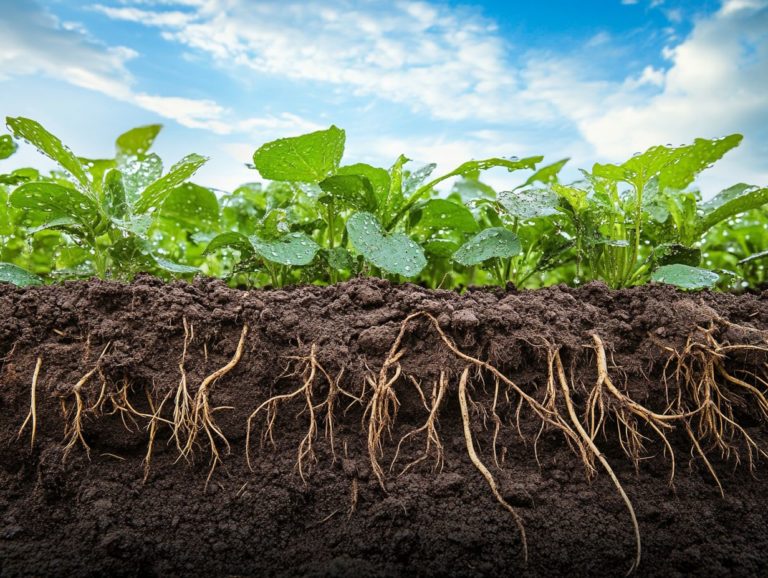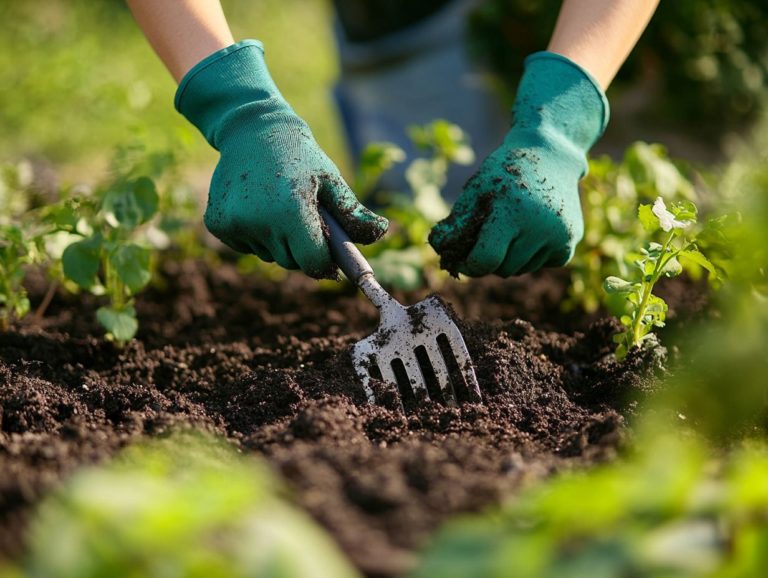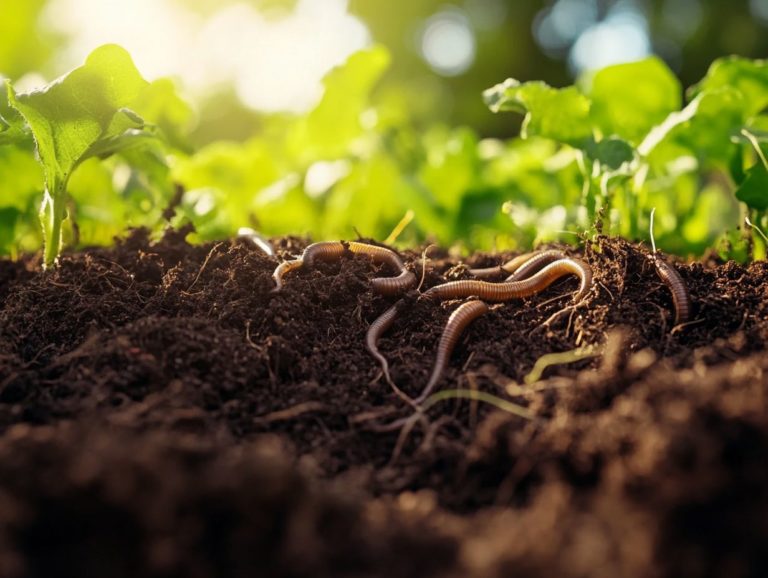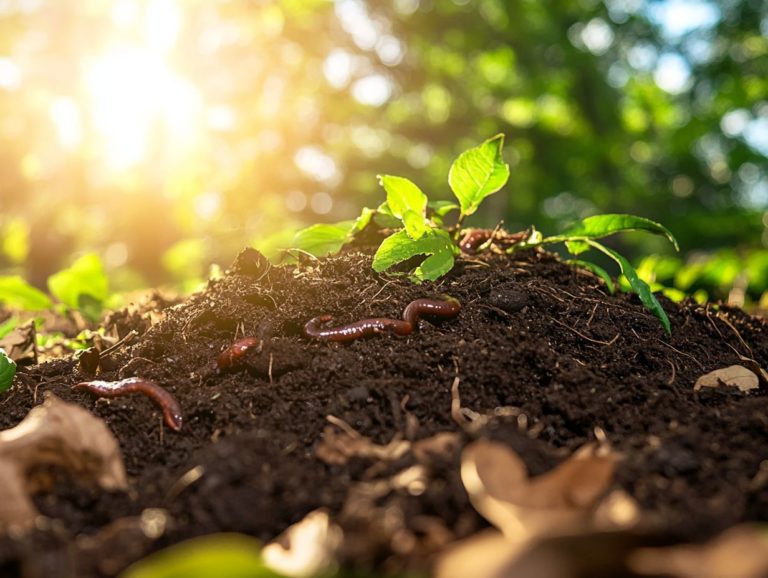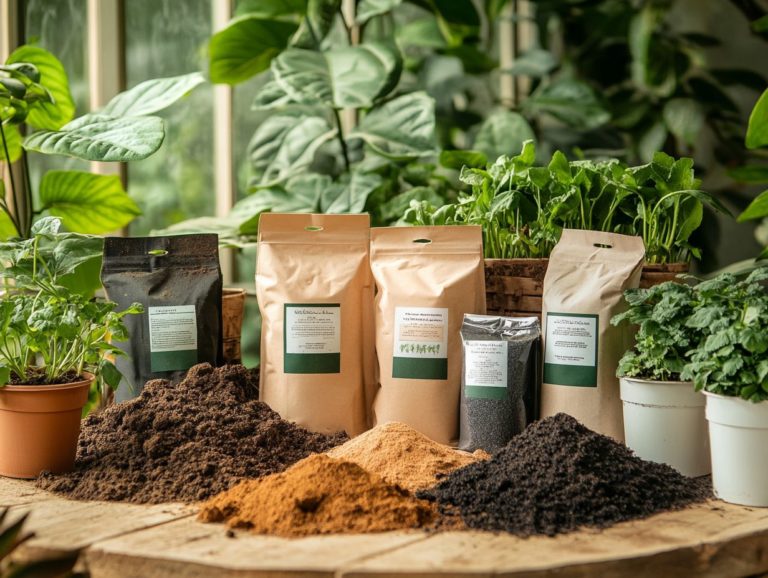Building Healthy Soil with Cover Crops
Cover crops are an invaluable asset for gardeners and farmers, poised to elevate soil health and sustainability. These remarkable plants serve multiple purposes, enhancing soil structure and fertility while delivering essential nutrients that your soil craves.
Dive into the compelling benefits of cover crops and explore the diverse types available. Learn how to choose the perfect ones tailored to your specific garden needs. Familiarize yourself with best practices for planting and managing these crops to ensure a seamless integration into your crop rotation for optimal yields.
Discover how cover crops can transform your garden into a thriving ecosystem, flourishing with life and productivity!
Contents
- Key Takeaways:
- What are Cover Crops?
- Benefits of Cover Crops for Soil Health
- Types of Cover Crops
- How to Choose the Right Cover Crops for Your Garden
- Planting and Managing Cover Crops
- Incorporating Cover Crops into Crop Rotation
- Frequently Asked Questions
- What are cover crops and how do they help build healthy soil by enhancing soil health principles?
- What types of cover crops are best for building healthy soil?
- When should cover crops be planted?
- How do cover crops improve soil health?
- Can cover crops be used in all types of soil?
- What are some tips for incorporating cover crops into my gardening or farming practices?
Key Takeaways:
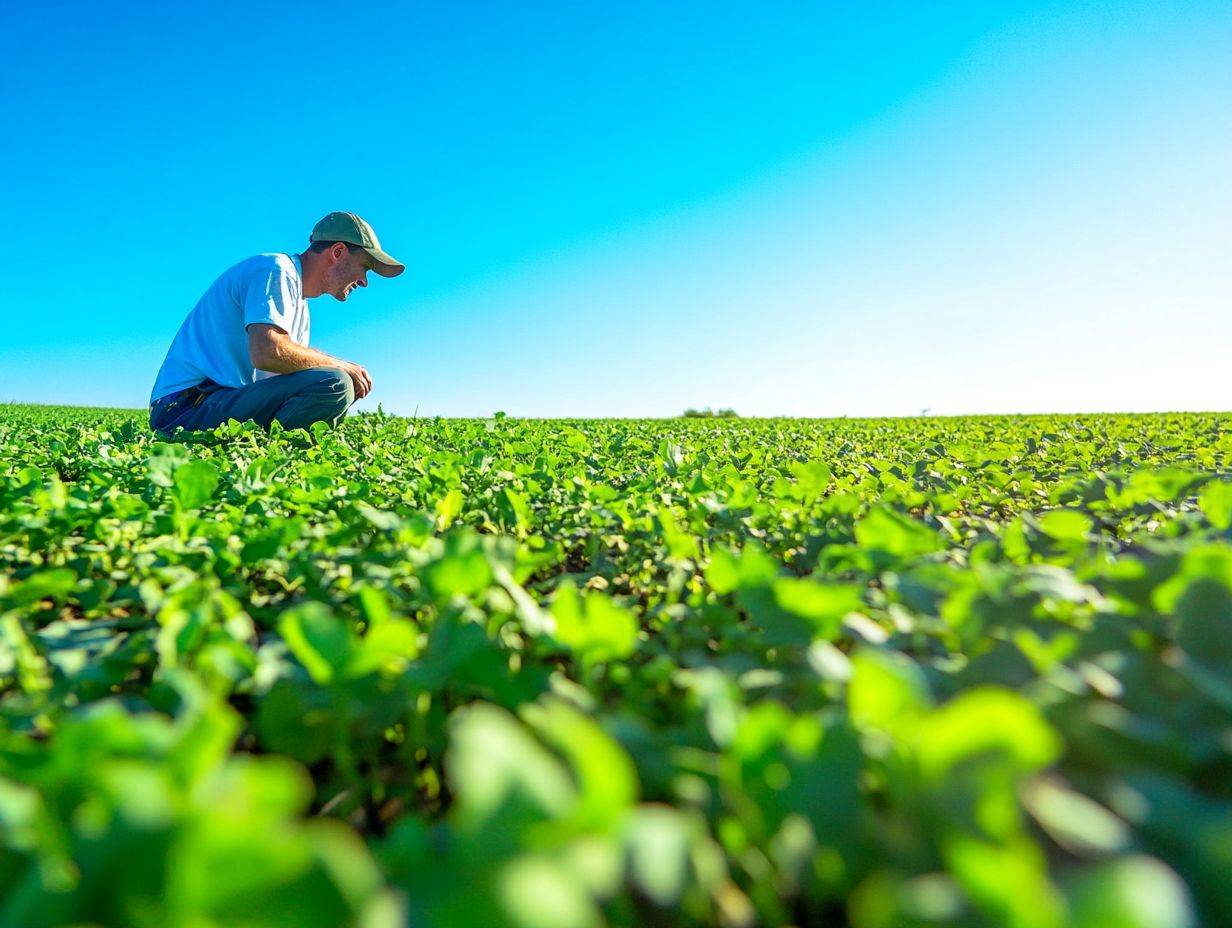
- Cover crops are plants grown specifically to improve soil health by enhancing soil structure and fertility.
- Different types of cover crops, such as annual and perennial, can be chosen based on climate and soil type.
- Incorporating cover crops into crop rotation benefits both soil health and crop health, leading to better yields.
What are Cover Crops?
Cover crops are specialized plants cultivated primarily to enhance soil health, boost soil biology, and promote sustainable farming practices. They play a crucial role in agriculture by preventing soil erosion and contributing organic matter.
These crops foster a diverse ecosystem that includes essential soil organisms like earthworms and mycorrhizal fungi, which help improve soil health. You can seamlessly integrate cover crops into your crop rotation strategies, allowing these living roots to enrich the soil and recycle nutrients, contributing to carbon buildup.
Benefits of Cover Crops for Soil Health
Cover crops provide numerous benefits for your soil health. They enhance nutrient levels and promote nitrogen fixation, a process where certain plants convert nitrogen from the air into a form that the soil can use. This can significantly boost soil fertility.
Selecting cover crop species like legumes and mustards unlocks the power of your soil, boosting microbial activity and carbon accumulation.
This not only contributes to a vibrant soil food web but also enhances overall soil vitality, ensuring your agricultural practices are both sustainable and productive.
Improving Soil Structure and Fertility
Cover crops are crucial for enhancing soil structure and fertility. They enrich the soil with organic matter, promoting soil aggregation and improving overall tilth.
The advantages of these crops extend beyond adding organic material. Their vigorous root systems penetrate and break up compacted soil layers, facilitating better aeration and drainage. This process creates a network of channels that allows water to infiltrate more efficiently and minimizes surface runoff.
The variety of plant roots introduced by cover crops contributes to healthier soil ecosystems, nurturing a robust community of microorganisms. These organisms thrive in environments rich in organic matter, enhancing nutrient retention and availability, ultimately resulting in more fertile land that supports productive crops, as detailed in the role of cover crops in pest control.
Types of Cover Crops
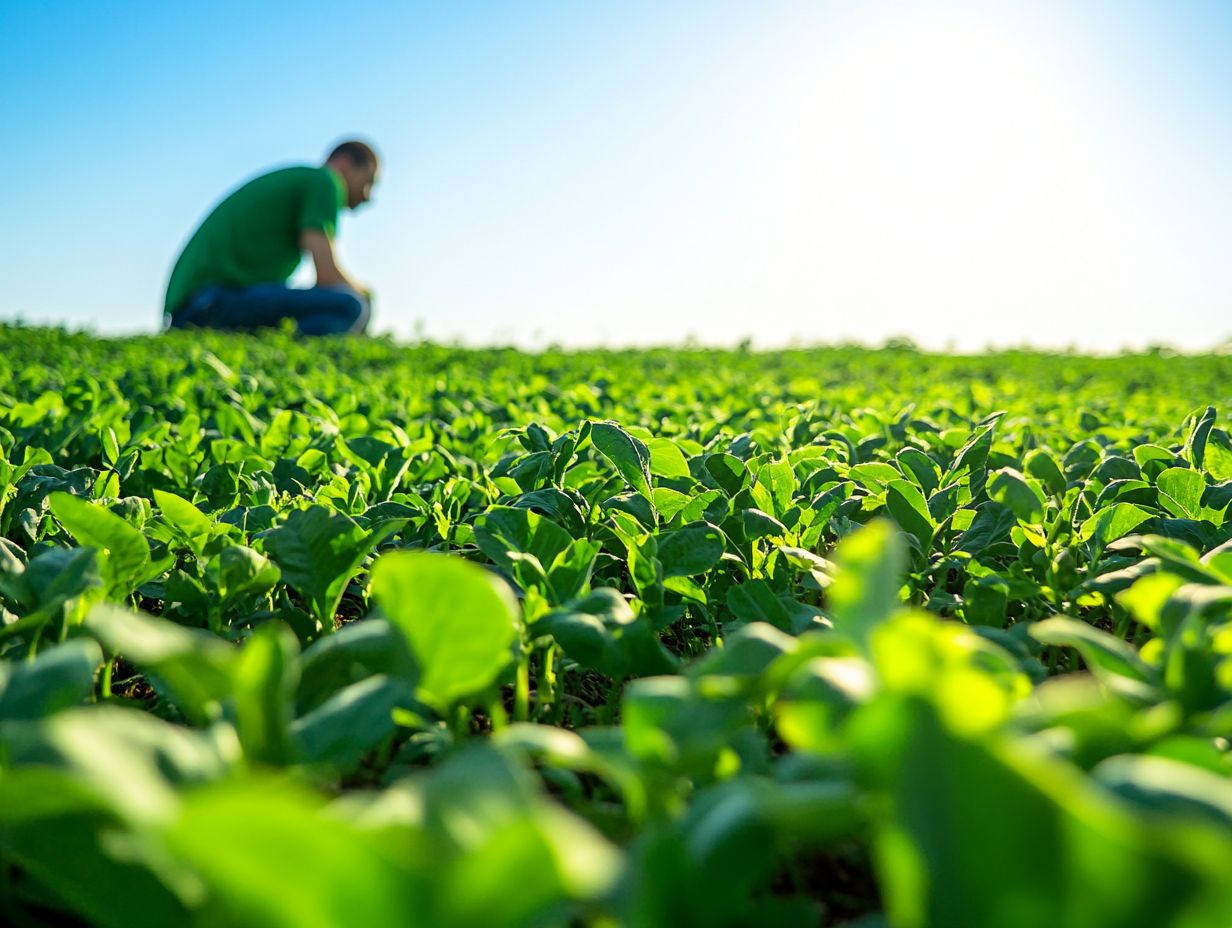
Cover crops can be classified into annual and perennial varieties, each offering unique advantages suited to particular farming systems. Annual cover crops, such as rye, clovers, and vetches, are sown for just one growing season.
In contrast, perennial cover crops develop deep taproots, enhancing soil moisture retention and nutrient cycling over the long term.
Annual vs. Perennial Cover Crops
Annual cover crops are your go-to for a single growing season. Perennial cover crops stick around for multiple years. Both are crucial in enhancing soil moisture and boosting crop yields.
You might lean towards annual cover crops for their swift establishment and versatility in various crop rotations. They excel at alleviating soil compaction and suppressing weeds.
On the flip side, perennial varieties offer long-term benefits. Their continuous root systems improve soil structure and stability, creating a habitat for beneficial microorganisms.
This enduring presence supports consistent nutrient cycling and nutrient management. Perennials reach deep into the soil to access nutrients, making them available for successive crops.
Ultimately, each type has unique advantages. This gives you the flexibility to choose based on your environmental conditions, sustainability goals, and economic considerations.
How to Choose the Right Cover Crops for Your Garden
Selecting the right cover crops for your garden requires a clear understanding of your local climate, soil type, and specific agricultural objectives.
Conducting soil tests to evaluate soil health and nutrient requirements is a critical step in this process. Choosing the right cover crops is essential for maximizing their advantages within your farming system and enhancing your crop rotation strategies.
Considerations for Climate and Soil Type
When selecting cover crops, consider both the climate and soil type. These elements significantly affect the success of your cover cropping strategy in sustainable farming.
Understanding how various climate zones from arid to temperate impact growth patterns is key. For example, cool-season crops like rye and vetch flourish in colder climates, while warm-season varieties such as sorghum and cowpeas are better suited for warmer regions.
Soil type is another crucial factor in your selection process. If you re working with sandy soils, deep-rooted species like daikon radish can improve aeration. In contrast, clay soils might benefit from legumes like clover, which enhance nitrogen levels and soil structure.
Ultimately, the right combination of cover crops will promote soil health and boost agricultural productivity.
Planting and Managing Cover Crops

To successfully plant and manage cover crops, you must adhere to best practices that maximize their benefits for soil health and structure. This includes proper timing, selecting the right species, and managing crop residues.
By implementing these practices, you can ensure cover crops contribute to soil management and enhance overall agricultural productivity. This contributes to a more sustainable farming system.
Best Practices for Successful Growth
Implementing best practices for the successful growth of cover crops requires you to optimize conditions for soil moisture retention and enhance microbial activity.
Consider techniques like no-till planting, a method that reduces soil disturbance. This preserves soil structure and moisture levels while promoting beneficial organisms.
When selecting cover crops, ensure they align with your local climate and soil types. For instance, legumes effectively fix nitrogen, boosting nutrient availability.
Regularly monitoring your soil health through testing can guide your management decisions. This helps create optimal conditions for crop development and resilience.
Incorporating organic matter like compost is a proven strategy to enrich the soil. This further supports a thriving microbial community that enhances overall crop performance.
Incorporating Cover Crops into Crop Rotation
Incorporating cover crops into your crop rotation systems stands out as a highly effective strategy. This practice enhances crop health, improves soil fertility, and supports the growth of your cash crops.
By doing so, you cultivate a farming system that is both resilient and sustainable.
Get ready to transform your garden! Start your cover crop journey today.
Benefits for Crop Health and Yield
Integrating cover crops into your farming can greatly enhance crop health and yield. For more information on how to build soil health with cover crops, these plants boost soil nutrients and promote sustainable practices.
These plants add organic matter to the soil, improving nutrient availability. They also act as barriers against soil erosion, protecting your topsoil.
Their root systems enhance soil structure, which helps with water infiltration and retention. This creates a resilient ecosystem that supports beneficial microorganisms, resulting in healthier crops.
Some cover crops also fix nitrogen, which reduces your need for synthetic fertilizers and helps maintain ecological balance.
Frequently Asked Questions
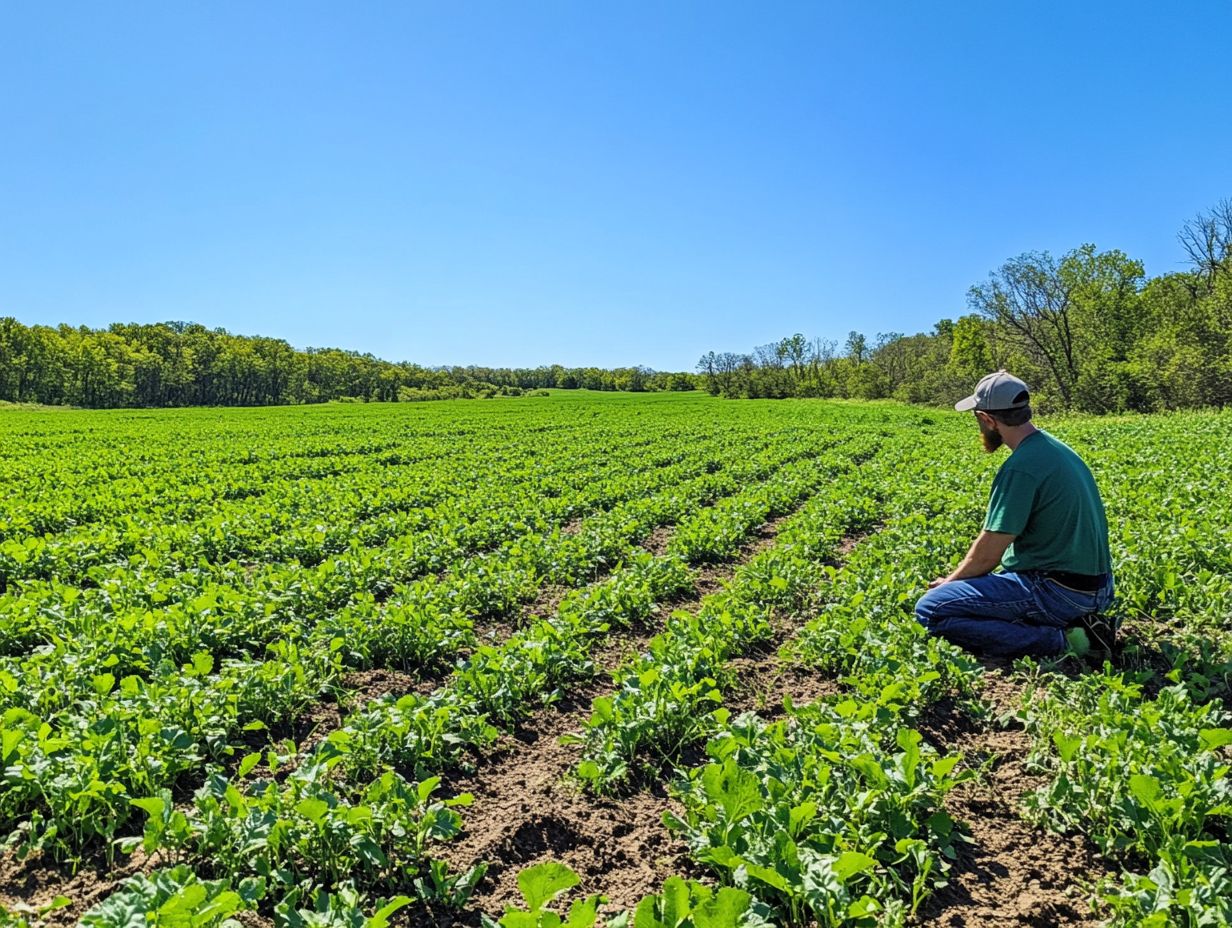
What are cover crops and how do they help build healthy soil by enhancing soil health principles?
Cover crops are plants grown specifically to improve soil health. They can be planted after harvesting a main crop or during fallow periods to add organic matter, improve soil structure, and prevent erosion.
What types of cover crops are best for building healthy soil?
Different cover crops provide various benefits, so it’s best to choose a mix that suits your specific soil needs. Legumes, like clover and vetch, help add nitrogen to the soil. Grasses, such as rye and oats, contribute organic matter and improve soil structure. Brassicas, like radishes and turnips, assist in breaking up compacted soil. Incorporating leguminous cover crops can significantly enhance nitrogen levels and boost crop yields, making them invaluable to your farming system!
When should cover crops be planted?
Cover crops should be planted after a main crop is harvested or during periods of fallow. The timing depends on your location and climate, but generally, it’s ideal to plant cover crops in late summer or early fall, before the first frost. Planting cover crops is a fantastic way to boost your soil health! Utilizing crop rotation can also optimize the timing and effectiveness of cover crops, improving soil conditions.
How do cover crops improve soil health?
Cover crops improve soil health in several ways. They add organic matter to the soil, boosting microbial activity and enhancing soil structure.
These crops also prevent erosion and reduce nutrient runoff, keeping the soil in place while retaining vital nutrients. They enhance nutrient cycling and promote beneficial organisms like earthworms and mycorrhizal fungi, which are essential for a thriving soil ecosystem.
Can cover crops be used in all types of soil?
Yes, cover crops can thrive in various soil types. Choose the right cover crop mix based on your specific soil.
For sandy soil, legumes can increase nitrogen levels. In clay soil, grasses can improve structure. Conduct soil testing to find the best mix for your needs.
What are some tips for incorporating cover crops into my gardening or farming practices?
Start small and try different cover crop mixes to discover what works best for your soil and climate. Properly terminate cover crops before planting your main crop for optimal results.
In smaller gardens, you can cut cover crops and leave them on the soil surface to decompose. For larger fields, tilling or mowing may be necessary to incorporate them into the soil, preventing regrowth that competes with main crops. Conservation tillage can help maintain soil structure and moisture, boosting overall soil health.

